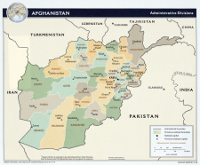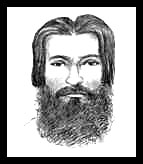US and Afghan forces killed 38 Haqqani Network fighters during a clash in eastern Afghanistan near the border with Pakistan.
The battle began Friday night in the Musa Khel district in Khost province, along the border with neighboring Paktia province, and near the border with Pakistan, and continued into today. US and Afghan forces were conducting an operation in the district when more than 200 Haqqani Network fighters attacked. Thirty-eight Haqqani Network fighters were killed, according to an Afghan police official.
“The clash erupted in Musa Khel district Friday night and so far 38 Taliban rebels have been killed,” Abdul Hakim Ishaqza, the provincial chief of police for Khost, told Xinhua.
The US military confirmed the battle took place but did not provide an estimate of enemy casualties.
“Precision airstrikes were used in self defense against a large number of armed insurgents,” the International Security Assistance Force stated in a press release.
Both the US military and Afghan forces received reports of civilian casualties and are investigating.
“We are aware of conflicting reports of civilian casualties made by local officials and are therefore reviewing the operational details of the engagement,” ISAF stated.
Today’s clash in Khost is the second in the province in more than a week. On June 9-10, US and Afghan forces killed Haqqani Network commander Fazil Subhan and an undisclosed number of fighters during a raid in the Shamal district. Subhan and his team were holed up in fortified fighting positions in the district. He was a known facilitator of al Qaeda fighters and aided them in entering the country from Pakistan.
Also, Afghan and US forces killed 38 Haqqani Network fighters in neighboring Paktika province on June 16, according to an Afghan police officials. The operation took place in the Surobi and Komal districts, two known strongholds of the Haqqani Network.
Background on the Haqqani Network
The Haqqani Network has extensive links with al Qaeda and the Taliban, and its relationship with Pakistan’s Inter-Services Intelligence agency has allowed the network to survive and thrive in its fortress stronghold of North Waziristan. The Haqqanis control large swaths of the tribal area and run a parallel administration with courts, recruiting centers, tax offices, and security forces. They have established multiple training camps and safe houses used by al Qaeda leaders and operatives, as well as by Taliban foot soldiers preparing to fight in Afghanistan.
The Haqqani Network has been implicated in some of the biggest terror attacks in the Afghan capital city of Kabul, including the January 2008 suicide assault on the Serena hotel, the February 2009 assault on Afghan ministries, and the July 2008 and October 2009 suicide attacks against the Indian embassy. American intelligence agencies confronted the Pakistani government with evidence, including communications intercepts, which proved the ISI’s direct involvement in the 2008 Indian embassy bombing. [See LWJ report “Pakistan’s Jihad” and Threat Matrix report “Pakistan backs Afghan Taliban” for additional information on the ISI’s complicity in attacks in Afghanistan and the region.]
The Haqqani Network is led by Jalaluddin Haqqani and his son, Sirajuddin. Jalaluddin is thought to be ill and is considered the patriarch of the network. Siraj runs the daily operations and is the group’s military commander.
Siraj is one of the most wanted Taliban and al Qaeda leaders in the Afghan-Pakistan region. The US military has described Siraj as the primary threat to security in eastern Afghanistan. He is the mastermind of the most deadly attacks inside Afghanistan, including suicide assaults in Kabul, and he is the senior military commander in eastern Afghanistan. He is the leader of the Taliban’s Miramshah Regional Military Shura, one of the Afghan Taliban’s four regional commands [see LWJ report, “The Afghan Taliban’s top leaders“].
Siraj is considered dangerous not only for his ties with the Afghan Taliban, but also because of his connections with al Qaeda’s central leadership, which extend all the way to Osama bin Laden. Siraj is a member of al Qaeda’s Shura Majlis, or top council, US intelligence sources told The Long War Journal. In a tape released in April 2010, Siraj admitted that cooperation between the Taliban and al Qaeda “is at the highest limits.” On March 25, 2009, the US Department of State put out a $5 million bounty for information leading to the capture of Siraj.
Despite Siraj’s ties with al Qaeda, and the Haqqani Network’s use of suicide attacks, some top US military commanders have stated that Jalaluddin Haqqani, his father, and Gulbuddin Hekmatyar, another supporter of al Qaeda, are “absolutely salvageable” and ripe for negotiations.
“The HIG already have members in Karzai’s government, and it could evolve into a political party, even though Hekmatyar may be providing al Qaeda leaders refuge in Kunar,” Major General Michael Flynn, the top military intelligence official in Afghanistan, told The Atlantic in April 2010. “Hekmatyar has reconcilable ambitions. As for the Haqqani network, I can tell you they are tired of fighting, but are not about to give up. They have lucrative business interests to protect: the road traffic from the Afghanistan-Pakistan border to Central Asia.”
Sir Graeme Lamb, a senior adviser to General McChrystal, echoed Flynn’s view on Hekmatyar and Haqqani, and discounted the groups’ close ties to al Qaeda.
“Haqqani and Hekmatyar are pragmatists tied to the probability of outcomes,” Lamb also told The Atlantic. “With all the talk of Islamic ideology, this is the land of the deal.”
A Haqqani Network leader known as Zakim Shah serves as the shadow governor of Khost province. Khost, Paktika, and Paktia provinces are the main strongholds of the Haqqani Network in eastern Afghanistan. The Haqqani Network also has a presence in the provinces of Logar, Wardak, Nangarhar, Ghazni, Zabul, and Kabul.
The Haqqani forces in Paktika province are commanded by Mullah Sangeen Zadran, a senior lieutenant to Sirajuddin Haqqani. A US military intelligence official told The Long War Journal that Sangeen also commands forces outside of Paktika and that he has become one of the most dangerous operational commanders in eastern Afghanistan.
Last summer, Sangeen took credit for the kidnapping of a US soldier who apparently stepped away from his post at a combat outpost in Paktika on June 30, 2009. US forces in eastern Afghanistan launched a massive manhunt for the soldier, but failed to find him. The soldier is believed to be held across the border in Pakistan’s Taliban-controlled tribal agency of North Waziristan.
US and Afghan forces hit the Haqqani Network hard in the summer of 2009 during a series of raids in Khost, Paktika, Paktia, Logar, and Zabul. Major battles were fought in mountainous regions as the joint forces assaulted heavily defended Haqqani Network “fortresses.” The raids failed to dislodge the Haqqani Network from the provinces.
The Haqqani Network has also been heavily targeted by the CIA in the covert air campaign in Pakistan’s tribal areas. Siraj has been the target of multiple Predator strikes. His brother, Mohammed, who served as a military commander, was killed in a February 2010 strike in North Waziristan.










6 Comments
IF they try and attack over open ground the muj will take a beating. I always thought our COP’s and some FOB’s should have mines, barbed wire, claymores. Those guys from 173 never had a chance, but still this goes on. Give them 1 ave of approach, and kill them all. Outstanding job, love to know wat US element was involved.
Besides Haqqani group, many civilians are also killed and they are also counted as fighter. This not happens rarely but it is very often.
@Sports News: Do you have any source for your serious allegation?
There is always gonna be CD. Its widely known the talibs/aq use civs as human shields, and now our hands are kinda tied. We do not intentionally kill civs, but where do you draw the line? IF you are taking fire from a compound how many innocents are there? Your guys are pinned down, you need air. If iam to choose between them and me and mine, they are goners. Also, the use of claymores, mines to keep them out should be used, you don’t want them swarming ur COP.
The CIA funded Haqqani & now we are going after him. amazing waste of taxpayers $$ & human lives.
@paul: That’s a pretty simplistic view of the world in 2010.